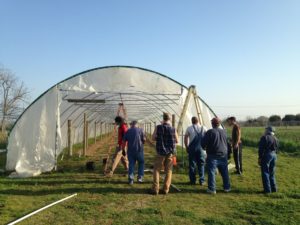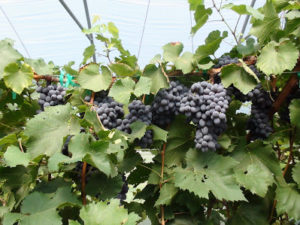High Tunnel Tree Fruit and Grape Production for Eastern Growers
by Guy K. Ames
Almost all of the domestic organic table grapes and tree fruits sold in the United States come from the West. In the eastern United States, organic production of perennial fruits is complicated by myriad insects and diseases. If an eastern grower could find a technique to grow good-looking organic fruit that didn’t cost any more than transporting western fruit to eastern markets, then eastern organic fruit production could be competitive. Growing grapes and tree fruits in high tunnels could be one of these techniques.
Properly managed, a high tunnel can allow a grower to get her product to market before her competition in the spring, and can extend a crop’s market season into late fall or winter. By keeping untimely frosts, rain, hail, and excess wind off crops, the grower can also reduce losses from pests, disease, and environmental damage.

Putting the finishing touches on a high tunnel intended for table grapes at the University of Arkansas research farm. Note the grape trellis already in place. Building trellises is best done before the tunnel goes up. (Photo by Susan Alman, University of Arkansas)
A high tunnel can take a lot of worry out of production, but it is not without its own imperatives. First among these is daily maintenance. Rain does not fall in the high tunnel, so irrigation is up to you. Unless you utilize temperature-sensitive timers and mechanical retractors, you’ll be the one raising and lowering the side coverings. Because the few pests that are common to high tunnels tend to have a rapid reproduction rate, during the growing season you should be doing pest-monitoring daily. In short, though you’ve taken some of the uncertainty out of growing, the cost is increased vigilance and labor.
Diseases and Pests in High Tunnels
For the organic grower, the main benefit high tunnels offer is the ability to exclude and inhibit disease. Splashing, blowing rain is the main vehicle for spreading most fruit diseases. Where rain can be excluded, potentially devastating diseases like brown rot can be almost, though not entirely, eliminated. The one notable exception is powdery mildew, which thrives with high humidity and is the one consistent disease problem on plants in greenhouses and high tunnels. Luckily, powdery mildew is not terribly difficult to control organically.
Though high tunnels are often left open at the ends, and sides are lifted for ventilation, surprisingly few insect pests move in. The pests that seem to be most problematic in high tunnels are the same as in greenhouses: white flies, aphids, and mites. A relatively new pest that has proven troublesome is the spotted winged drosophila (SWD). If pests are getting in, small-mesh screen can be used to block them at the ends and sides, though this represents another monetary investment.
Because high tunnels are semi-closed systems, naturally occurring beneficial insects don’t often find their way inside. Conversely, introduced beneficials cannot easily disperse into the outside environment, so you might get more biological pest control for your money.
What Fruit Crops Look Profitable for High Tunnel Culture?
Foremost among the candidates for high tunnel production are seedless table grapes, sweet cherries, peaches, nectarines, and plums. Research has already indicated that these can be grown successfully and organically in high tunnels.
Organic sweet cherries are among the highest-valued fruit crops. High tunnel production can bring the crop in earlier. Also, high tunnel culture can come close to eliminating the threat of bacterial canker and brown rot. Furthermore, being able to control water during the final ripening period gives growers with high tunnels a big advantage in avoiding cracking problems.
The sweet cherry is probably the most studied tree fruit in university-sponsored high tunnel research, and the most tried among early-adopting private growers. However, profitability of sweet cherry or any other fruit crop produced in high tunnels is highly dependent on good management. With cherries, this means using the latest dwarfing rootstocks and training systems to get the most out of the small area protected by the high tunnel.

High tunnel-grown grapes in University of Arkansas research yielded three times the fruit of the same variety grown outside the tunnel. (Photo by Susan Alman, University of Arkansas)
Seedless table grapes also look like a very good candidate for high tunnel culture. The extra expense of trellising grapes is more than compensated by the earlier bearing of grapes grown in high tunnels. Also, early research indicates that grapes experience huge benefits in quality and yield when grown in tunnels.
Peaches and nectarines are probably right behind sweet cherries in the value of the harvested crop. They are also exceedingly difficult to grow organically in the East because of brown rot, plum curculio, and other threats. For growing in high tunnels, training systems that have been developed to keep the trees very small, yet highly productive, are used.
Plums, apricots, and their crosses are stone fruits for which frost control is as important as disease control when considering the value of a high tunnel system. Apricots, especially, are notorious for blooming too early and losing their crops to spring frosts. A properly managed high tunnel can help apricots and other stone fruits set a viable crop by protecting them from frost damage.
Additional Production Considerations
Because honeybees have problems navigating in high tunnels, high tunnel growers will have to provide pollination either by hand, or by purchasing bumblebee colonies. Table grapes have a “self-contained” pollination system, so nothing needs to be done to insure pollination for grapes.
Without rain or overhead irrigation, some bulky organic fertilizers like compost will not readily break down and move into the soil. Because these fruit crops are perennials, cover crops cannot be relied upon for nutrition after the initial planting, so consider the plants’ nutritional needs before planting.
Post-planting nutritional needs will be met with fertigation, precision hand-application of compost or pelletized organic fertilizers, or hand-application of liquid organic fertilizers. Dry fertilizer materials will have to be placed where the soil is wet from irrigation; otherwise, the nutrients from such materials will not move into the root zone.
It’s advisable to remove the plastic cover every winter to insure that the trees meet their chill requirement, but also to allow rain to rinse out excess salts from the fertilizers. This is a time when manure or compost could be applied.
While under cover, the trees or vines will be dependent on the grower for water. Even during dormancy, if the soil gets too dry, trees can die. There are many ways to supply water, but anything that gets the foliage or fruit wet will be undoing the big advantage of growing fruit under cover. Most growers choose standard drip irrigation.
Though a high tunnel can facilitate pest and disease management on tree fruits and grapes, growing woody perennials is significantly more complicated than growing most annual crops. In fact, because you’re growing in the tight, prescribed area of a high tunnel, cropping efficiency becomes even more important than when these fruiting plants are grown outdoors. This means that you will almost certainly need to adopt modern intensive techniques that rely on dwarfing rootstocks. And you will have to adopt the right training system for the varieties and the market you choose. Viticulture (grape growing) is yet another world. Growing tree fruits and/or grapes are not endeavors that should be entered into without study and, preferably, experience.
Economics
The big question, of course, is whether a grower can make money growing fruit in a high tunnel. The quick answer is “yes.” The simple truth of that is in the thousands of acres dedicated to fruit culture in high tunnels in China. In general, there are higher marketable yields and earlier harvesting within high tunnels. Another quick indicator of the potential profitability of high tunnel fruit production is that in many years, whole crops of unprotected stone fruits are lost to untimely frosts that a high tunnel crop could avoid.
Nevertheless, this is not a low-input system, and returns have to cover 1) costs of construction of the high tunnel itself (materials and labor), 2) an irrigation system, 3) maintenance costs, 4) the non-productive time before long-lived fruit plants start bearing, as well as 5) the risks of damage to the tunnel itself from extreme weather events.
The initial cost of the tunnel (materials and labor) is generally going to be the greatest expense. Costs can vary, but a typical 30-foot wide, 100-foot long high tunnel will likely cost $3,000 to $10,500. Detailed budgets for constructing high tunnels are easy to find on the Internet. The Natural Resources Conservation Service (NRCS) of the United States Department of Agriculture (USDA) may be able to underwrite the major share of the cost of a high tunnel for individual growers through the Environmental Quality Incentives Program (EQIP). Talk with your local Soil & Water office about this possible avenue of support.
Detailed enterprise budgets for organic tree-fruit and grape production in high tunnels do not yet exist and perhaps that is because the very best systems have yet to be determined. Nevertheless, with 1) an NRCS-underwritten tunnel, 2) marketable crops possibly two to three times the yield of outdoor-grown crops, 3) consistent frost protection sometimes saving entire crops, and 4) the possibility of price premiums for local, organically grown fruit, a good manager could make substantial profits with high tunnel-grown fruit.
Conclusion
Profitable high tunnel culture of table grapes and certain tree fruits holds significant promise for organic growers, especially in the eastern United States, where organic culture of these fruits has proven very difficult. The main benefit for organic growers is disease and insect control, but other benefits, like earliness to market and reducing rain-induced cracking, are also attainable. For more information on growing fruit in high tunnels, consult the ATTRA publication High Tunnel Tree Fruit and Grape Production for Eastern Growers, available free online at the ATTRA Sustainable Agriculture program website, www.attra.ncat.org.


You talked about length and width. What about height? Any hyperlinks to the right “training system?” Thanks. Justin
Hi Justin,
Most of the resources that I’ve found say that the height is pretty flexible as long as t’s a minimum of 6-7 feet tall (you want to be able to walk inside of it). Take a look at these two resources from SARE and USDA NRCS, and let me know if you have any further questions!
We have grown figs in our high tunnel for the past 3 years. We started with rooted cuttings, mostly of Brown Turkey and a couple of Chicago Hardy. About 35 plants. They are on drip irrigation for 4 to 5 hours a day.One year we got a lot of ripe fruit before the frost. Another year, mostly ripe. The trees die to the ground each winter and we start again with root sucker/shoots. We have started to severely prune in summer leaving only vertical shoots. This method seems to work in Ithaca, NY
Regarding sweet cherry trees.
1. Up to 3000 sq feet according to the NRCS. How many trees per 3000 square feet?
2. Can pollination through bees be conducted in high tunnel?
Hi Kevin,
I would direct your questions about sweet cheery trees to the author of the article, Guy Ames. This publication is out of the SE ATTRA office. You can contact them at:
NCAT’s Southeast Office:
20 E. Spring St., Suite 101
PO Box 3657
Fayetteville, AR 72701
(479) 442-9824
(866) 442-6085
Good luck!
thanks for all information i got thanks